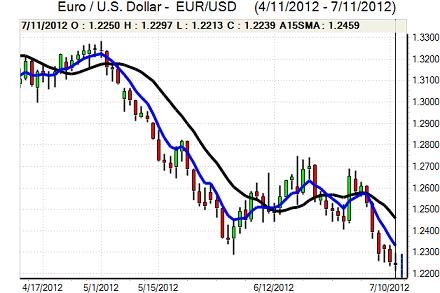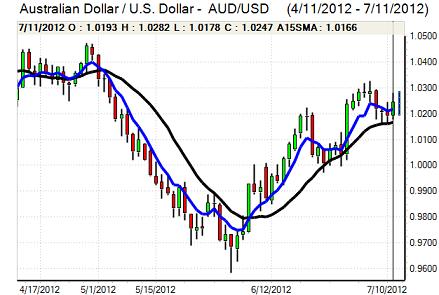EUR/USD
The Euro initially found support in the 1.2250 region against the dollar on Wednesday and pushed generally higher during the European session. Spain announced a further EUR65bn package of measures to curb the budget deficit and attempt to cut the deficit to the target 3.0% target level by 2014. The headline measure was an increase in VAT to 21% from 18%. There was a series of cuts to tax reliefs, although it was offset to some extent by a cut in income tax rates.
There was a series of labour-market protests to coincide with the fresh austerity measures and Prime Minster Rajoy was forced to admit that it was a measure of last resort. There was a decline in Spanish bond yields following the announcement, but there were also major concerns that fresh austerity measures would drag the economy deeper into recession with the threat of more severe labour-market protests. There were further concerns surrounding potential delays to the German Constitutional Court ruling.
The Euro stalled close to the 1.23 level and retreated sharply to lows to lows below 1.2230 ahead of the Federal Reserve minutes with low liquidity leading to choppy trading. There were also reports of Euro selling in the context of The Swiss National Bank redistributing its reserves out of the Euro.
Minutes from the Federal Reserve meeting in June confirmed that there had been a wide-ranging debate and significant divisions within the FOMC. A few members continued to promote the case for further easing at this time. The majority were more concerned over the threat of a slowdown and also stated that further easing might have to be considered, but did not want to take immediate action. There were also calls for a discussion on new methods to support the economy which suggests that there are important reservations over a further round of quantitative easing.
The minutes tended to dampen risk appetite with some disappointment that a more aggressive tone had not been signalled and the Euro dipped to fresh 2-year lows below 1.2220 before recovering slightly.

Source: VantagePoint Intermarket Analysis Software
Call now and you will be provided with FREE recent forecasts
that are up to 86% accurate* 800-732-5407
If you would rather have the recent forecasts sent to you, please go here
Yen
The dollar found support on dips to the 79.15 region against the yen on Wednesday and pushed sharply higher to highs in the 79.75 area. There were reports of semi-official bids on dips towards the 79 level with the currency also drawing support as it approached the 200-day moving average.
There was also market speculation that the Bank of Japan could decide to intervene to curb yen gains and there was also some easing of risk aversion which curbed defensive yen demand.
At its latest policy meeting, the Bank of Japan increased its asset-purchase programme to JPY45trn was JPY40trn previously, but also cut the loan programme by JPY5trn so the net quantitative easing programme was left on hold. The dollar initially spiked higher to a peak near 80 against the yen before sliding back to the 79.50 region.
Sterling
Sterling held a firm tone against the dollar during the European session on Wednesday with a high in the 1.5570 region ahead of the US open. The Euro was also unable to sustain a move back above the 0.79 level. The UK currency retreated sharply back to the 1.5515 area in New York.
The extent of Sterling safe-haven demand will continue to have an important impact in the short term. The latest UK 10-year bond auction will be watched closely on Thursday to assess the strength of underlying defensive demand for UK securities.
There were further serious underlying concerns surrounding the UK economic outlook which had some impact in dampening Sterling demand, especially with expectations that the economy contracted again during the second quarter.
Swiss franc
The dollar found support in the 0.9770 area against the franc on Wednesday and pushed to a high in the 0.9820 region following the Federal Reserve minutes as European currencies remained on the defensive.
There will be further expectations that the National Bank will be forced to intervene aggressively to protect the 1.20 minimum level, especially with the Euro remaining under widespread selling pressure on the crosses. There will also be further pressure for additional policy tools such as capital controls to ease pressure on bank intervention.

Source: VantagePoint Intermarket Analysis Software
Call now and you will be provided with FREE recent forecasts
that are up to 86% accurate* 800-732-5407
If you would rather have the recent forecasts sent to you, please go here
Australian dollar
The Australian dollar pushed to highs in the 1.0280 region against the US dollar on Wednesday before retreating to the 1.0230 region. Commodity prices showed some degree of resilience during the day which helped curb selling pressure on the Australian currency.
The latest employment data was significantly weaker than expected with an employment decline of 27,000 for June which reversed a revised 27,800 gain the previous month and the unemployment rate moved to 5.2% from 5.1%. There are likely to be further concerns surrounding the Asian growth outlook with the latest Chinese GDP data due for release on Friday.



